By William B. Allmon
On September 2, 1864, after a hundred-day campaign from southern Tennessee through northwestern Georgia, Sherman’s armies entered Atlanta after its evacuation by Confederate forces. “Atlanta is ours, and fairly won,” Sherman jubilantly wired to Washington. Of course, it had not been won without costs: Sherman’s armies had lost 31,687 killed, wounded, and missing in one of the most astonishing overland struggles of the war so far.
But the capture of Atlanta, a key Confederate bastion, restored Union morale, which had suffered owing to heavy casualties in both Georgia and Virginia. “Although Northern voters in November would also be influenced by Admiral David G. Farragut’s victory in Mobile Bay and by Major General Philip Sheridan’s defeat of Rebel forces in the Shenandoah Valley, there is little doubt that the fall of Atlanta was the major political turning point of the war because voters sniffed the aroma of ultimate victory,” Civil War historian Phil Gottschalk wrote. “The North redoubled its resolve and its efforts.”
Hood’s 40,000-Man Army
Atlanta’s capture also deprived the South of the city’s railroad machine shops, cannon factory, arsenal, rolling mill, machine works, and countless other small shops and factories. Although Lt. Gen. Ulysses S. Grant, General-in-Chief of the Union armies, wrote that by taking Atlanta, Sherman had “accomplished the most gigantic undertaking given to any general in the war,” Sherman himself was not satisfied. “I had not accomplished all,” he wrote, “for Hood’s army, the chief objective had escaped.”
Following its evacuation of Atlanta, Confederate General John Bell Hood’s battered Army of Tennessee, after suffering 24, 979 casualties out of an original force of 68,000 men, pulled back to Lovejoy Station, 35 miles southeast of Atlanta, to regroup. The Army of Tennessee had been weakened by disease, desertion, dead and wounded in battle—20,000 in the month and a half since Hood took over command from General Joseph E. Johnston—plus immense losses of small arms, artillery, and ammunition. Hood’s troops were bone tired and short of shoes and clothes. “Even food was scarce,” author David Nevin wrote, “because Georgia farmers had become increasingly reluctant to sell their produce in exchange for the inflated Confederate paper currency.” Hood’s Army was in no condition to attack Sherman’s superior numbers.
Despite its losses in men and materiel, Hood’s Army of 40,000 men in three corps was still a force to be reckoned with, and a threat that Sherman, despite his superior numbers, could not ignore.
But Sherman did not attack Hood at Lovejoy Station. Instead, on September 7, he pulled back to Atlanta. His army needed a brief rest, author Shelby Foote wrote, “in which to digest its gains and shake its diminished self together, while its leader pondered in tranquility his next move.” Even with reductions due to casualties, Sherman’s three armies—Maj. Gen. David M. Stanley’s Army of the Cumberland, Maj. Gen. Oliver O. Howard’s Army of the Tennessee, and Maj. Gen. Jacob D. Cox’s Army of the Ohio—were still twice as strong as Hood’s, with 80,000 men in six corps of nine divisions.
By remaining in Atlanta, however, Sherman left Hood free to strike at his long supply line. The Union armies around Atlanta were sustained by the single-track Atlantic & Western Railroad, extending 130 miles back to Chattanooga, Tenn. Fully aware of the importance of this line, Sherman had taken precautions to protect the railroad by posting strong detachments from Marietta, Ga., to Chattanooga, Tenn. “All the important bridges were likewise protected by good block-houses, admirably constructed, and capable of a strong defense against cavalry or infantry,” Sherman wrote.
Sherman wasn’t concerned with attacks on the railroad by Confederate cavalry led by Maj. Gen. Joseph “Fighting Joe” Wheeler, he wrote, “for they rarely made a break which could not be repaired in a few hours.” He was more concerned with the Army of Tennessee’s infantry: If Hood’s troops captured a section of the tracks, they could choke off his army. “It was absolutely essential to keep General Hood’s infantry off of our main route of communication,” Sherman said.
Hood Devises a Bold Gamble to Attack the Union
Without the strength to confront Sherman, and nowhere to fall back to, Hood decided on a bold gamble: He would attack the Union supply line and force Sherman to come out of Atlanta. To accomplish this, Hood would recross the Chattahoochee River with his entire army and cut the railroad. Sherman would follow to protect his line of communication, giving the Confederates a chance to defeat him. By seizing the initiative, Hood hoped to restore his army’s morale and nullify Sherman’s advantages. “He was sure that an offensive would be a tonic for his soldiers, infusing them with renewed fighting spirit,” Nevin wrote. However risky the plan, Hood believed now was the time to act: “Sherman is weaker now than he will be in the future, and I am as strong as I can expect to be.”
Starting on September 18, Hood shifted his army from Lovejoy Station to Palmetto Station, 25 miles southwest of Atlanta. By September 21, the movement was complete and the Confederates dug in. From Palmetto Station, Hood was in an excellent position to strike at Sherman’s communications.
Four days after Hood’s completed movement to Palmetto Station, Confederate President Jefferson Davis arrived for a council of war with Hood and his corps commanders. The president approved the plan to attack Sherman. After two days of reviewing the troops and revising Hood’s plan, Davis left Palmetto Station on September 27. “Our cause is not lost,” he declared in a speech at Macon, Ga., the next day. “Sherman cannot keep up his long line of communications; retreat sooner or later he must.… When that day comes, the fate that befell the army of the French in its retreat from Moscow will be reenacted.…”
Jefferson Davis’s indiscreet speech was reprinted in several Georgia newspapers, which Sherman obtained through Union spies. “He made no concealment of these vainglorious boasts,” Sherman recalled, “and thus gave us the key to his future designs.… To be forewarned was to be forearmed.” By now, knowing that his army could not linger around Atlanta, Sherman had decided to cut himself loose from his supply line and march his army southeast through Georgia to the Atlantic Ocean.
But, before he could do that, Sherman had to neutralize Hood. Learning about Hood’s plans was difficult, however. “There was great difficulty in obtaining correct information about Hood’s movements from Palmetto Station,” Sherman remembered. “I could not get spies to penetrate his camps.”
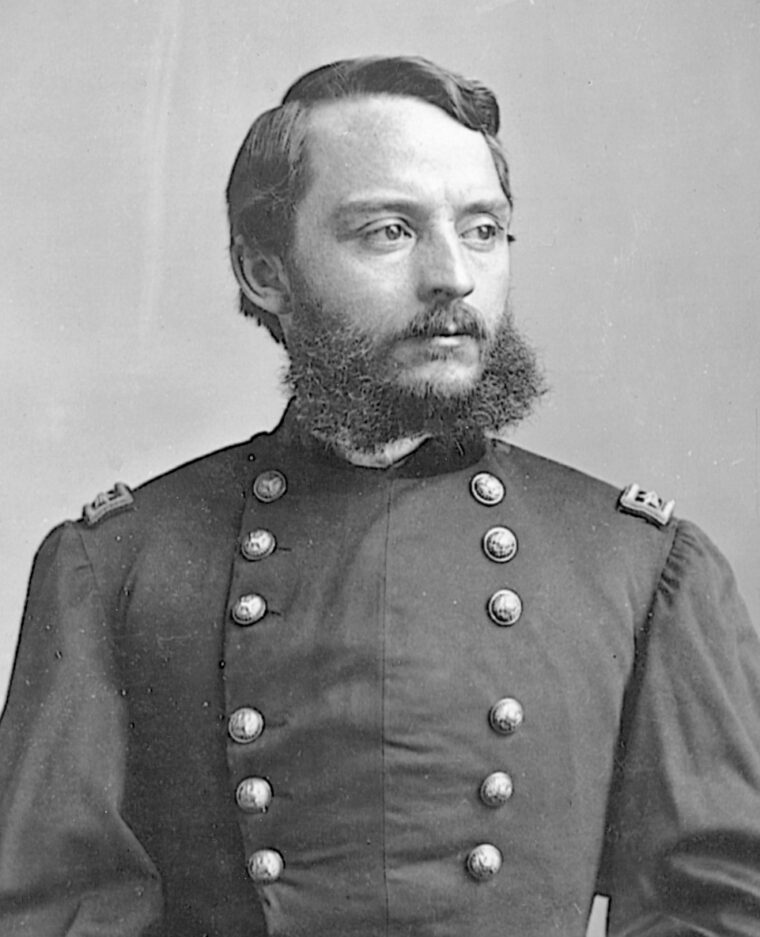
Despite this, Sherman took steps to counter Hood’s potential moves. On September 24, he had sent Brig. Gen. John M. Corse’s Fourth Division, XV Corps, to Rome, Ga., instructing him to “be prepared to act against any force that might threaten Bridgeport from the direction of Gadsen.” By September 28, he had strengthened the garrisons along the railroad, reinforced Union troops in Tennessee, and prepared his army to meet any threat.
He did not have long to wait. On the afternoon of September 29, Hood’s Army, now numbering 44,403 men, crossed the Chattahoochee River below Campbelltown, Ga., and headed north at a steady pace, covering 12 to 18 miles a day. By October 2, 1864 the Army of Tennessee was on Sherman’s supply line. Hood ordered Lt. Gen. Alexander P. Stewart’s Corps to strike the railroad; Lt. Gen. Stephen D. Lee’s Corps would cover their movement from Lost Mountain, while Lt. Gen. Benjamin Franklin Cheatham’s Corps continued toward Marietta.
The next morning, October 3, Stewart’s three divisions, covered by Brig. Gen. Frank Armstrong’s Cavalry Brigade, attacked the garrisons guarding the railroad. Major General William W. Loring’s Division attacked the railroad hamlet of Acworth, capturing a hundred Union troops; Maj. Gen. Edward C. Walthal’s Division struck Moon’s Station; and Maj. Gen. Samuel G. French’s Division took Big Shanty. Stewart’s Corps captured 600 Union prisoners, losing, Stewart reported, “not more than 12 or 15, mostly wounded.”
“To Destroy is a Soldier’s Joy”
Once all three towns were secured, Stewart’s men, like Sherman’s a few months earlier, began tearing up the railroad. “[The] track was torn up and huge fires built from the ties until the rails, laid across the fire, became red hot at their center and were grasped by the cooler ends, carried to trees, and bent until the ends met,” Gottschalk wrote. Captain James Boyce of French’s Division recalled his fellow soldiers enjoying wrecking the tracks, because “to destroy is a soldier’s joy.” Despite heavy rain, they worked far into the night. “By 3:00 pm of the 4th,” Stewart wrote, “the railroad was effectively torn up, the ties burned, and the rails bent for a distance of ten or twelve miles.”
Watching from Atlanta, Sherman’s first impression was that Hood was moving to Blue Mountain, Ala. where he could be supplied over the Selma & Talladega Railroad, and thence threaten middle Tennessee.
Sherman reported Hood’s movement to Grant, promising, “If Hood tries to get on our road, this side of the Etowah [River], I shall attack him.” By October 3, Sherman concluded that Hood would “strike our railroad nearer us, viz about Kingston or Marietta.” Leaving Maj. Gen. Henry Slocum’s 12,000-man XX Corps to hold Atlanta, Sherman started Howard’s Army of the Tennessee and Stanley’s Army of the Cumberland, five corps with 55,000 men, back toward Marietta, over the same Georgia hills he had fought over during the summer.
On the morning of October 4, while Stewart’s Corps demolished the railroad, Cheatham and Lee’s Corps headed for New Hope Church, where Hood had set up headquarters. From there at 7:30 that morning, Hood, unaware of Sherman’s advance or the situation in his area, ordered Stewart to send a division to the railroad town of Allatoona Station, 12 miles north of Acworth, thence to “destroy the bridge over the Etowah River” and “take possession of the place.”
Stewart received his orders at 11:30 am. Although Loring’s 4,500-man division and Walthal’s 2,700-man division were closer, Stewart chose French’s Division to attack Allatoona. Taking Hood’s orders to French himself, Stewart arrived at his headquarters in Big Shanty at noon, telling French, when he handed him Hood’s orders, “Here is a fine opportunity for you.”
A ‘Peculiar’ Order
The 54-year-old West Point graduate and Mexican War veteran considered his orders “peculiar.” Hood had sent neither Stewart nor French any information about Allatoona, its defenses, or how many Union troops were there. “It would appear, however, from these orders that the General-in-Chief [Hood] was not aware that the pass was fortified and garrisoned,” French reported. Despite this, neither French nor Stewart questioned the orders. “Stewart apparently transmitted Hood’s orders onto French with a mere pat on the back,” historian William R. Scaife wrote, “and French dutifully proceeded to his assigned task.”
French’s Division left Big Shanty for Allatoona at 3 pm. His division, which he had led since May 1864, consisted of three brigades. The first was led by Brig. Gen. William H. Young, with the 29th and 39th North Carolina Infantry Regiments, the 9th Texas Infantry, and the 10th, 14th, and 32nd Texas Cavalry (Dismounted). The second, under Brig. Gen. Francis M. Cockrell, comprised eight small Missouri regiments consolidated into four—the 1st and 4th Infantry, 2nd and 6th Infantry, 3rd and 5th Infantry, and the dismounted lst and 3rd Cavalry. The third fell to the command of Brig. Gen. Claudius Sears and comprised the 4th, 35th, 36th, 39th, and 46th Mississippi Infantry Regiments and the 7th Mississippi Infantry Battalion. Additionally, French had three four-gun artillery batteries commanded by Major John D. Myrick. In all his division comprised 3,276 officers and men, with 12 guns.
Seeing no danger in letting French’s Division attack Allatoona alone, Stewart with Loring and Walthal’s divisions rejoined Hood’s Army at New Hope Church. French was left advancing “all alone into the land occupied by the enemy, and Gen. Hood moved farther and farther away, leaving me isolated beyond all support or assistance.” As they marched, French’s men suspected where they were going. “Nearly all of us are satisfied that our destination is Allatoona,” Lieutenant George Warren of Cockrell’s Brigade wrote, “and the surprise of that stronghold the object of our expedition.”
While French’s Division moved toward Allatoona, the Union vanguard, with Sherman riding near the front, recrossed the Chattahoochee River and rendezvoused at the old Smyrna Camp battlefield. Moving quickly, Sherman’s troops crossed into the Georgia hills and entered Marietta later that day. Once there, Sherman learned that the telegraph had been cut above Marietta and the railroad had been torn up. The Union flag signal station on Kennesaw Mountain, under Lieutenant Charles H. Fish, reported “heavy masses of infantry, artillery and cavalry” marching north. Learning this, Sherman determined that the Confederates were after Allatoona.
Sherman was familiar with the railroad hamlet. Founded as a gold-mining town in the 1840s, Allatoona was a natural stronghold where one army could wait for an attack by a pursuing army. In May 1864, during the Atlanta Campaign, Confederate General Joseph E. Johnston established a defensive position around the pass and waited for Sherman to attack. Knowing a direct assault would be difficult; Sherman instead performed a series of flanking movements, forcing Johnston to evacuate the pass, which the Federals quickly occupied.
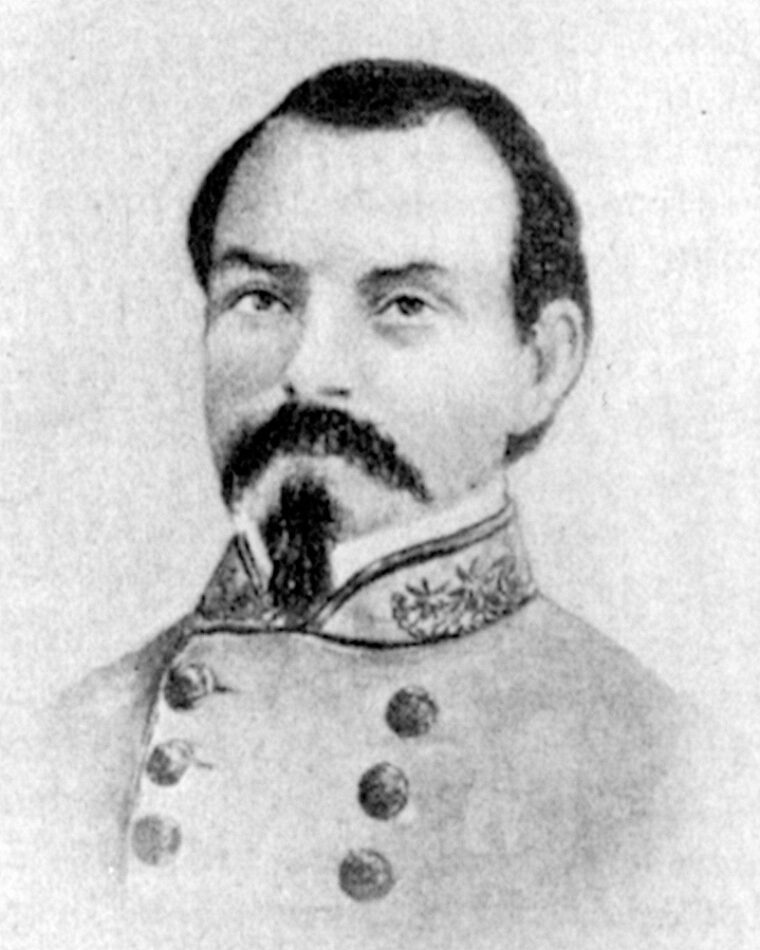
Union Troops Fortify Allatoona
A garrison was placed in the hamlet, which author David Evans described as “a wretched and forlorn looking town of four or five houses scattered around the south end of the railroad cut through Allatoona Mountain.” On June 6, 1864, Sherman ordered Allatoona fortified and prepared as a secondary base. By July 14, Union engineers had fortified both sides of the railroad cut, building a four-sided earthen fort encircled by a deep ditch east of the railroad, and a larger, six-sided redoubt on the western ridge. Each fort mounted a smoothbore Napoleon gun and two 3-inch rifled cannon, and was surrounded by trenches and rifle pits; the forest had been leveled for 200 to 300 yards west of the trenches, forming a barrier of fallen trees. The slope on both sides of the cut had also been cleared, giving both forts a good field of fire.
Once its defenses were complete, Sherman established his main supply depot there, placing a million pounds of hardtack and salt pork in warehouses near the railroad, along with 9,000 head of cattle in the valleys around the town. “I regard Allatoona of the first importance in our future plans,” Sherman declared. “It is a second Chattanooga; its front and rear are susceptible of easy defense and its flanks are strong.” Sherman placed such importance on the Allatoona depots that he stated in General Field Orders No. 57, on August 16, “The depots at the bridge, at Allatoona, and Marietta, will be held against any attack.”
Two months later, with Hood’s Army on the move, and part of it heading for Allatoona, its defense was uppermost in Sherman’s mind. Unable to move his troops there by rail because of the break in the tracks at Big Shanty, and concerned the Confederate force heading for Allatoona was large enough to smash the small Union garrison, Sherman sent a message, via signal flag from Kennesaw Mountain to Allatoona and from there by telegraph, to General Corse in Rome, Ga.: “General Sherman directs you to move forward with your entire command to Allatoona….”
Corse, a flamboyant 29-year-old ex-West Pointer, and one of Sherman’s favorite brigadiers, received Sherman’s relayed order at noon on October 4 and, he reported, “immediately got ready to move to Allatoona with the division as soon as the cars should arrive from Kingston.” A train was quickly dispatched from Kingston, Ga., but was delayed when its cars derailed. Getting them back on the tracks again took most of the afternoon and the 20-car train didn’t arrive in Rome until 7 pm.
A Train Loaded with 1,054 Soldiers and 165,000 Rounds of Ammo
“This was not enough to haul a brigade, much less a division,” Evans wrote, “but Corse could not wait any longer.” He hurried Colonel Richard Rowett’s Third Brigade, eight companies of the 39th Iowa and 50th Illinois Regiments, nine companies from the 7th Illinois Regiment, two companies of the 17th Illinois, and a detachment from the 12th Illinois—1,054 officers and men—plus 165,000 rounds of ammunition, onto the train. Loading was complete by 8:30, and the train set off for Allatoona.
Unaware that Union reinforcements were on their way there, French reached Acworth, six miles northwest of Big Shanty, at sunset, where he waited for rations to show up. Because he knew nothing about the roads, the terrain around Allatoona, or the fortifications, French wrote, “it was important to procure a guide.”
Eventually, French located 18-year-old Tom Moore, member of a local Confederate cavalry company, who agreed to be his guide. While his men rested, waiting for their rations to arrive, French spoke to two local girls who had visited Allatoona earlier that day, learning about the garrison and its fortifications, including a blockhouse near the Allatoona Creek Bridge, held by 80 Union soldiers commanded by Captain Peter McIntyre, which could stall his advance.
After waiting at Acworth for five hours, French resumed his advance at 11 pm over the narrow country roads. “The night was dark and the roads bad,” French recalled. He pushed his division across Allatoona Creek, halfway between Acworth and Allatoona, at midnight, October 5, 1864. Leaving Colonel Thomas Adaire’s 4th Mississippi Regiment to attack the blockhouse, French moved the rest of his division toward the town. The blockhouse held out until the Confederates withdrew from Allatoona.
Inside Allatoona, the Union garrison commander, Lt. Col. John E. Tourtelotte, having been alerted to the threat by a flag message from Sherman, strengthened his guard, barricaded all roads to the south, and prepared to set fire to a building in case of a night attack, “so my men could see even in the night, to a considerable extent, any approach of the enemy,” Tourtelotte wrote.
If the Confederates attacked Allatoona that night, Tourtelotte hoped to hold them at least until daylight when, he wrote, “We should have the full advantage of our superior position.” To hold the town, Tourtelotte had the 4th Minnesota and 93rd Illinois Regiments, seven companies of the 18th Minnesota Regiment, and the 12th Wisconsin Battery of four 10-pound Rodman rifled cannon and two 12-pound brass howitzers—976 men in all. Outnumbered by the approaching Confederates, Tourtelotte was also hoping for reinforcements to arrive, as promised by Sherman in a message he had received at 8:30 the previous evening: “General Sherman says hold fast. We are coming.”
“A Night Before the Battle and the Soldiers Cannot Rest”
There was no sign of the promised reinforcements when, shortly after midnight, Federal pickets near flat-topped Moore’s Hill, 1,100 yards south of town, encountered French’s vanguard. Within minutes, while skirmishers on both sides traded shots, Tourtelotte had his entire command under arms. At 1 o’clock in the morning, with sporadic firing still going on, the train with Corse and Rowett’s Brigade on board pulled into Allatoona and began unloading the troops and ammunition. After this was complete, Corse sent the train back to Rome to bring back the rest of Rowett’s Brigade and Lt. Col. Roger Martin’s First Brigade. But the train derailed after leaving Allatoona: No further reinforcements would arrive until after the battle was over.
After meeting with Colonel Tourtelotte and familiarizing himself with the fortifications, Corse ordered his men to stack arms and get some sleep. “But it is a night before the battle and the soldiers cannot rest,” Daniel Lieb Ambrose of the 7th Illinois wrote. “Men are hurrying to and fro: their voices are hushed, for thought is busy with them all; they are thinking of the coming strife.”
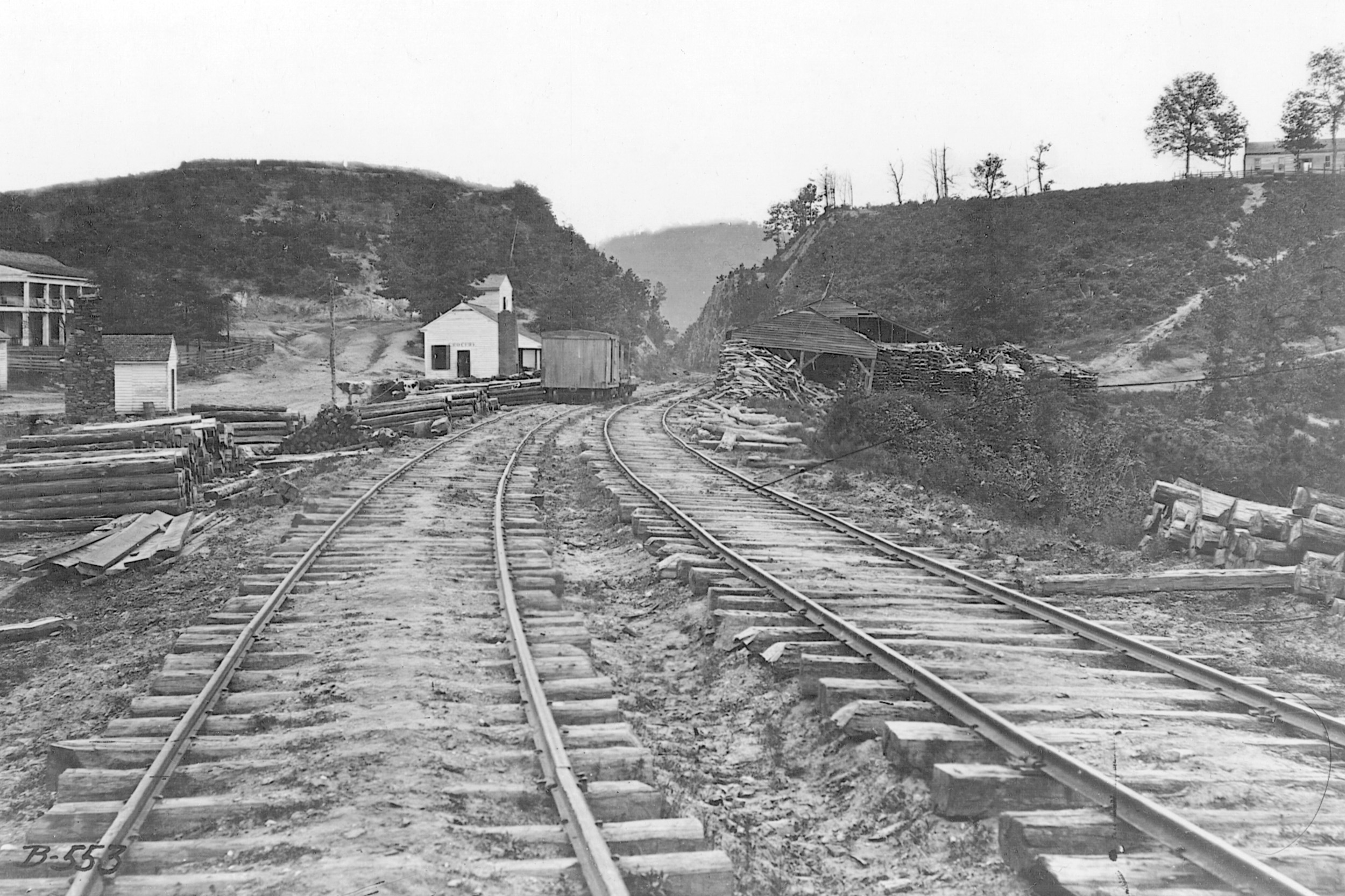
Moving as best they could through the dark wood, steep hills, and deep valleys, the Confederates crossed the railroad near Allatoona around 3 am. “They saw only one or two twinkling lights and heard nothing except occasional shots by their skirmishers and enemy outposts,” Gottschalk wrote. Ordering Major Myrick to place his guns on Moore’s Hill, from which they could sweep the area, and leaving the 39th North Carolina Infantry and 32nd Texas Cavalry (dismounted) to protect them, French continued his advance.
“But without roads or paths it was like the blind leading the blind,” one author wrote. After floundering around in the darkness for over an hour, French’s men found themselves in front of the Union defenses instead of on the main ridge. With Tom Moore acknowledging they were lost and that he could not find the way, French halted until daybreak.
“Although the rest would be a short one, weary soldiers were grateful,” Gottschalk said. “They had gotten little sleep during the night’s downpour and marched most of the previous 12 hours since leaving Big Shanty after a hard labor destroying track.”
At Allatoona, while French’s men rested, Corse positioned his troops for battle. The 7th Illinois, 39th Iowa, and a battalion of the 93rd Illinois were deployed in line of battle facing west. The 4th Minnesota, 12th, 50th Illinois, and 18th Wisconsin were positioned on the eastern hill, with the rest on the outpost and skirmish lines. Corse commanded the troops on the western redoubt, and Tourtelotte led those in the eastern redoubt. By sunrise, with sporadic firing going on between the skirmishers, every Union soldier in Allatoona who could carry a rifle—2,137 men in all—was on the firing line.
Resuming his march at first light, French’s men struggled up and down hills until they reached the high ground 600 yards west of the fortifications at 6:30 am and saw them for the first time. “The whole formed a mountain fortress,” French wrote, “with immense entanglements of abatis, stockades, stores, etc, to check any assault on the works.’’
“As I looked across the intervening space to the bristling forts and viewed the rugged Mountainside with the interminable abatis that lay between, and then cast my eyes along our slender line,” Lieutenant Warren recalled, “I thought to myself there will be hot work here if these regiments are made of resolute men.”
Surrender Allatoona!
As Major Myrick’s guns opened fire on the Union defenses at 7 am, French issued his battle orders: Sears’ Brigade would outflank the defenses from the north and attack their rear, while Cockrell and Young’s Brigades attacked eastward down the ridge. Knowing it would be an hour before his troops were in position, after consulting his brigade commanders French decided to try and persuade the Federals holding Allatoona to surrender.
After a few minutes searching for a white cloth to use as a flag of truce, French sent his adjutant, Major David R. Sanders and Lieutenant E.T. Freeman, escorted by 16 men from the 29th North Carolina Infantry Regiment, toward the Union lines with his message. Reaching the picket line, Sanders delivered the note to Lieutenant William C. Kinney of Company E, 93rd Illinois Infantry, saying he would wait 15 minutes for a reply.
French’s message was first taken to Colonel Rowett, who delivered it to General Corse near the western redoubt. Corse opened the note and read: “Sir, I have placed the forces under my command in such positions that you are now surrounded, and, to avoid a needless effusion of blood, I call upon you to surrender your forces at once and unconditionally. Five minutes will be allowed you to decide. Should you accede to this, you will be treated in the most honorable manner as prisoners of war.”
“General French must either be a fool, or else he thinks somebody else is one,” Corse said. Taking a notebook out of his pocket, Corse wrote: “Your communication I acknowledge receipt of, and would respectfully reply that we are prepared for the needless effusion of blood whenever it is agreeable to you.” Tearing the reply out of his notebook, Corse handed it to an aide. “They will be upon us now,” he informed Colonel Tourtelotte.
Surrender or Fight?
By now, Major Sanders had been waiting for 16 minutes. “The time limited in the instructions to await an answer having expired, and it appearing quite evident that no reply would be sent,” Sanders wrote, “the flag of truce was declared at an end.” While returning to French’s headquarters, Sanders rode past Cockrell’s Brigade which was deployed to attack. A Missourian called out, “Is it surrender or fight, Major?”
“Fight,” Sanders replied.
After hearing of Sanders’ rebuff, French received a dispatch from Sears telling him that his brigade was held up by high water from a mill dam on Allatoona Creek, which would take an hour for them to go around. Impatient at the delay, French immediately ordered Young and Cockrell’s Brigades to attack.
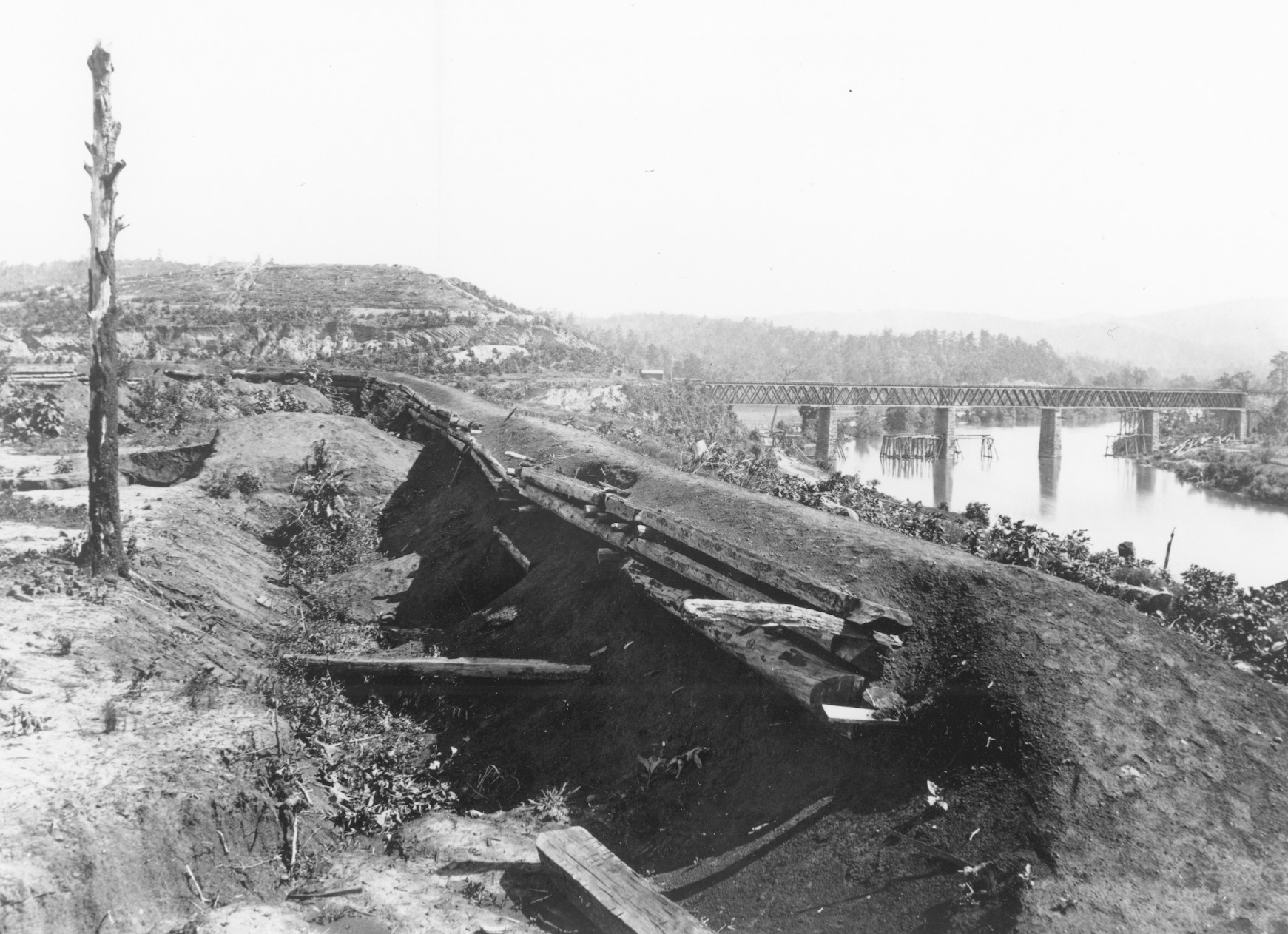
The quiet, hazy Indian summer day was shattered by rifle and cannon fire at 9 am, as Cockrell and Young’s Brigades advanced. “The regiment moved forward in fine order,” Major James H. McReynolds, 9th Texas Infantry, reported, “considering the great obstacles, such as fallen trees, brush, rugged ground, &c.” Advancing along the ridge which, French wrote, “barely admitted a company front,” with three companies in advance as skirmishers, the Confederates drove through the woods, chased off Union skirmishers, and pressed forward under heavy fire toward the western redoubt through tangles of abatis.
On the other side, the 7th Illinois and 39th Iowa Regiments, reinforced by a battalion from the 93rd Illinois Regiment, led by Colonel Rowett, waited for them in the western redoubt‘s trenches and rifle pits. As the Confederates emerged from the woods both regiments opened fire; the 7th Illinois with their 16-shot Henry repeating rifles and the 39th Iowa with muzzle-loading Springfield rifles.
“The enemy fought like men and when within 20 yards of the entrenchments so deadly was their fire that our lines halted and the contest seemed doubtful,” James Bradley, K Company, 3-5th Missouri, remembered. The Missourians took cover and began clearing paths through the obstacles in front of them, while others searched for a way to outflank Rowett’s line.
For more than an hour, while Young’s Brigade reorganized itself, Cockrell’s men worked their way through the abatis. Young’s men quickly moved up behind Cockrell’s and, at 10:20, once the obstacles were cleared, the Missourians and Texans rose, leveled their bayonets, and charged, screaming the rebel yell. “We then pushed forward under a very destructive fire,” Major McReynolds recalled, “every man striving for who would be first to mount the enemy’s works.”
A “Sublime Spectacle” of Battle
“Solid shot and shells, grape and canister from double shotted cannon and a hailstorm of bullets were rapidly and accurately poured into the ranks of the Confederates as they recklessly advanced,” Lieutenant Harvey Trimble, 93rd Illinois Infantry, remembered. “And yet, not withstanding their fearful losses at every step, they still advanced.… The spectacle was sublime.”
The Federals in the redoubt stood their ground, laying a murderous fire upon the advancing Confederates. General Young was wounded and five Confederate color bearers cut down as the Missourians and Texans swarmed over the parapets. “Here sabers crashed, bayonets crossed, and clubs and rocks were hurled back and forth,” Bradley wrote. A desperate struggle broke out around the 39th Iowa’s regimental flag as Confederates grabbed the colors and the 39th’s color guard clutched the staff. The struggle continued until Sergeant John M. Ragland, lst-4th Missouri, tore the flag from the breastworks and carried it away. For his bravery, Ragland was later promoted to lieutenant.
While Cockrell and Young’s men attacked the west redoubt, Sears’ Brigade, after an hour of going around the dam, formed a line of battle on both sides of the railroad north of Rowett’s position, facing south. With Sears leading, the Mississippians swept down on the Federals “like a wintry blast from the north,” Union cavalry officer Mortimer Flint recalled. Attacked by front and flank, Union troops began falling back to Corse’s fort, covered by companies E, G, and K of the 39th Iowa, led by Lt. Col. James Rodfield, holding the trenches north of the Cartersville Road. Redfield was struck in the foot while encouraging his men; getting back up, another shot broke his leg. Despite his wounds Redfield continued leading his men until he was killed by a bullet in his heart.
The Iowans stubbornly held off Sears’, Young’s, and Cockrell’s Brigades, disregarding their own heavy losses, allowing the remaining 7th and 93rd Illinois troops to slip back to Corse’s fort. Once they had withdrawn, the 39th Iowa, after losing 94 men killed or wounded, also fell back. The Confederates, bloody and weary after capturing the outer defenses, paused to regroup.
Hurrying into the fort, the surviving Federals were heartened to see fresh bluecoats approaching. During the fighting, Corse ordered Lt. Col. William Hanna’s 50th Illinois, along with the 12th Illinois and 18th Wisconsin, to reinforce the west fort. Quickly obeying Corse’s order, Hanna double-quicked his men down the hill, over the tracks, across a footbridge spanning the railroad cut, and back up the hill into the fort. The reinforcements crowded into the trenches while the rest of Rowett’s men stampeded into the fort. “Men standing on the embrasure, over the cannon and on the parapet, seized the extended hands of those on the outside,” Trimble wrote, “and with the aid of those in the rifle pit at the base of the wall, literally lifted them into the fort.” By 11 am, with the exception of the 4th Minnesota in the east fort, Corse’s force was concentrated behind the west fort’s wall or in the trenches around it.
Outside the fort, French’s men regrouped and pressed in for the kill, but were driven back by heavy fire. The Confederates fell back, rallied, and came on again; Cockrell and Young’s Brigades charged the fort four times, without success.
For four hours the fighting raged. “Every Union soldier was his own commander,” Trimble recalled. “There was not even a lull in the musketry firing from the beginning to the end of it.” French’s men made no further frontal attacks, but kept firing from every house and hillside in the area, working their way closer and closer to the western redoubt. They took advantage of the “rough ground surrounding the fort,” Corse reported, “filling every hole and ditch, seeking shelter behind every stump and log that lay within musket range … completely enfilading our ditches and rendering it impossible for a man to expose his person above the parapet.” Slowly French’s men closed around the fort, filling it with dead and wounded.
At 1 in the afternoon, Corse was struck in the face by a spent minié ball, which severed a vein, nicked his ear, and knocked him cold. Rowett took command while Corse was taken below the parapet, where his wound was bandaged.
Union Troops Preferred Death Over Surrender
With ammunition running low, Rowett, hoping to conserve the supply, ordered a cease-fire. Many Union soldiers, thinking Rowett wanted to surrender, cried out, “Never,” and “Die first.” The words brought Corse out of his stupor, and he jumped up, cursing angrily: “No surrender, by God! Hold Allatoona!”
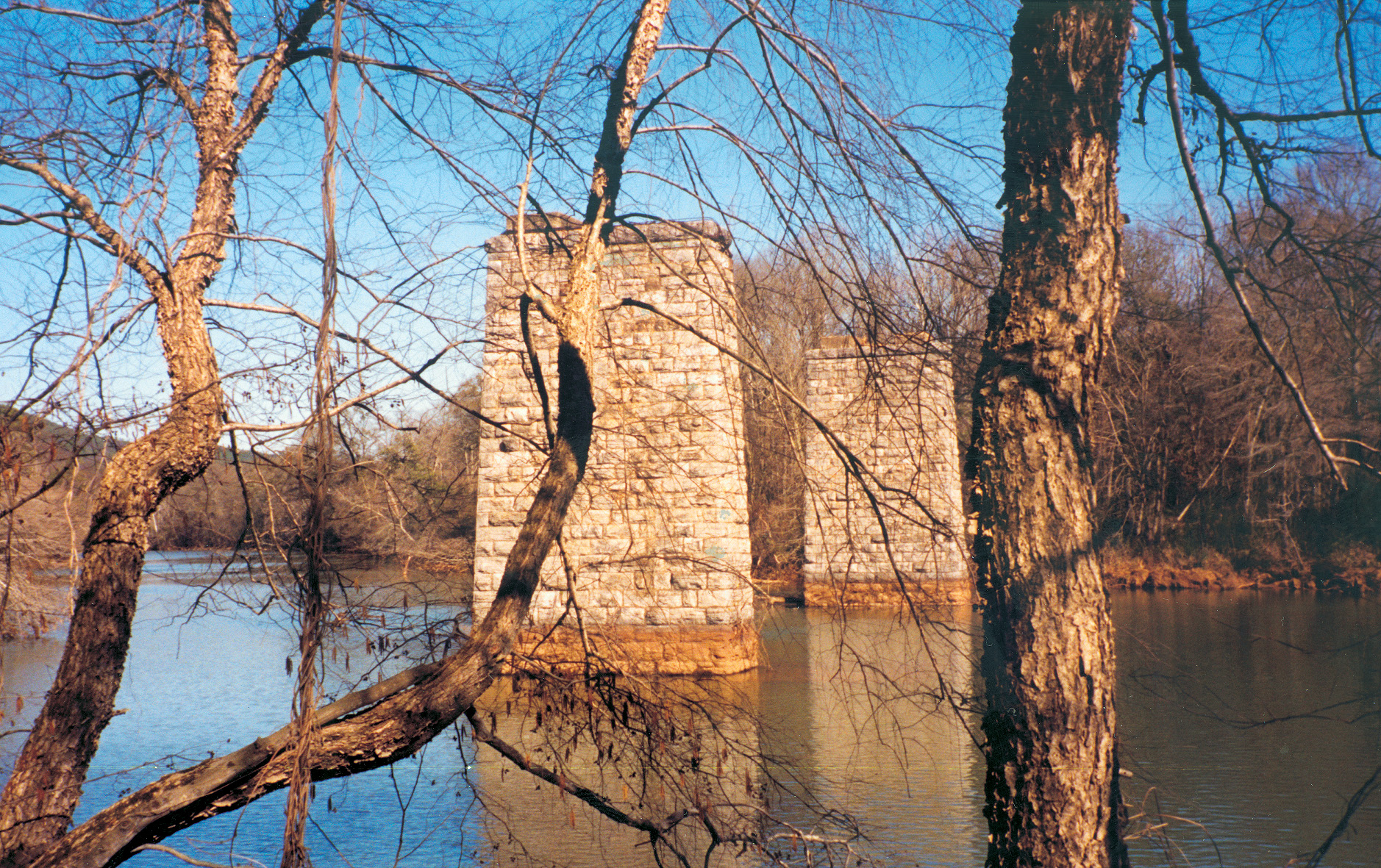
A few moments later, Rowett was struck by a shell fragment and carried off the parapet. Despite the heavy Confederate fire, Captain Robert Koehler, 12th Illinois Regiment, recalled, “The men fought with veteran coolness, bravery and determination without deserting their perilous position.” But as time wore on, Corse’s position became worse; bursting shells set cotton bales on fire, but there was no water; the artillery was silent for lack of ammunition. The crowded redoubt, Union officer William Ludlow wrote, was “as bloody as a slaughter pen.… And the same unuttered prayer hung on every parched, powder blackened lip, ‘Oh! That Sherman or night would come!’”
Outside the fort, French prepared his troops for another assault. “The Federal forces were now confined to one redoubt,” he reported, “and we occupied the ditch and almost entirely silenced their fire, and were preparing for the final attack.” Once he was ready, French was certain his men would finally overcome the last Union resistance in the fort, and capture Allatoona.
But it was not to be. Earlier that morning, French received a dispatch from Frank Armstrong warning that Union troops were moving up the railroad. Then, at 12:15, he received another dispatch (later proven false) reporting enemy forces were “entering Big Shanty” and moving to cut off his retreat from Allatoona.
“This changed the whole condition of affairs,” French recalled. Convinced his escape route would be cut off, French decided to withdraw, “however depressing the idea of not capturing the place after so many had fallen, and when in all probability we could force a surrender by night.” He ordered Cockrell, Young, and Sears to withdraw their brigades; Major Myrick’s artillery to pull back from Moore’s Hill; and Colonel Adaire’s regiment to burn the Allatoona Creek bridge, then rejoin the division. Cockrell and Young both protested, saying their men “wanted to remain and capture the place.” But French refused. “I deemed it of more importance not to permit the enemy to cut my division off from the army.”
Sears began pulling his regiments back at 12:30, Cockrell and Young’s brigades following at 1:30. As they pulled back, Union soldiers in the fort believed they were massing for a charge.
“Hold your fire for orders and aim low,” Corse told his men. “Officers, draw your revolvers. No Libby Prison for us.” Preparing for a last stand, 7th Illinois infantrymen drew their last Henry rifle cartridges while other regiments fixed bayonets. In his official report, Corse claimed that his men repelled the final Confederate assault with “such a heavy and continuous musket fire” that it “was impossible for the enemy to rally.”
An End to the Bloody Battle of Allatonna
In reality, French’s men quietly withdrew from their positions in front of the fort and, he said, “reformed on the original ground west of the works,” waiting for Sears’ Brigade. At 3:30, after Sears arrived, French’s troops formed up and marched southward to the Allatoona Creek Bridge. After Adaire’s men, assisted by Cockrell’s Brigade, finally captured the stubborn Union blockhouse, they burned the bridge and rejoined French south of the town. With that, the Battle of Allatoona ended.
French’s exhausted and riddled brigades sloshed along in the rain and darkness of October 5 to catch up with Stewart’s Corps at New Hope Church, 12 miles away. French reported his losses at 122 killed, 443 wounded, and 234 missing, or 799 total. Reaching New Hope Church before dawn on October 6, the morale of French’s men hit bottom. “Not only did the men who had fought so gallantly turn away sadly,” Bradley recalled, “but the failure cast a gloom over the whole Confederate army.”
Back at Allatoona, Corse’s men spent October 6 strengthening their positions and gathering up the Rebel dead and wounded. Corse later reported burying “213 rebel dead, capturing 3 stand of colors and about 800 small arms,” plus 411 prisoners of war. His own losses were 143 dead, 352 wounded, 212 missing, for a total of 706. At 2 o’clock in the afternoon Corse sent Sherman a dramatic message: “I am short a cheek bone and an ear, but am able to whip hell yet.”
“The Thermopylae of the Civil War”
“Your head is worth more than a dozen of any I have to spare,” Sherman replied. Pleased with Corse for saving Allatoona, on October 7, in Special Order Number 86, Sherman gave the “thanks of the army” to Corse and his men for their “determined and gallant defense of Allatoona.” Catching up with Corse in Rome a week later, and finding him with only a scratch on his cheek, Sherman couldn’t resist rubbing it in. “Corse, they came damn close to missing you, didn’t they?”
Called “the Thermopylae of the Civil War” by one author, Allatoona had a profound effect on the war in Georgia. “Had Corse lost the important supply base,” Nevin wrote, “Grant and the high command might well have dashed Sherman’s hopes for a march to the sea.”
Sherman used the fight at Allatoona as proof that a southward march to the sea was a good idea. By late October, after unsuccessfully chasing Hood into north Georgia, Sherman asked Grant’s permission to abandon Atlanta, march away from Hood’s Army, and “make Georgia howl” all the way to the sea. On November 10, 1864, Grant authorized Sherman “to move according to the plan he proposed; that is, cutting loose from his base, giving up Atlanta, and the railroad back to Chattanooga.”
Sherman’s Army left Atlanta on November 10 on their way to the sea. “Here, then, may rest the appraisal of Allatoona’s importance,” author Fred Brown wrote. “Not for the supplies stored there, but for the effect its loss would have had on Grant’s consideration of Sherman’s pet project.” While the Battle of Allatoona did not directly lead to Sherman’s march, its outcome was an important factor in making it a reality.
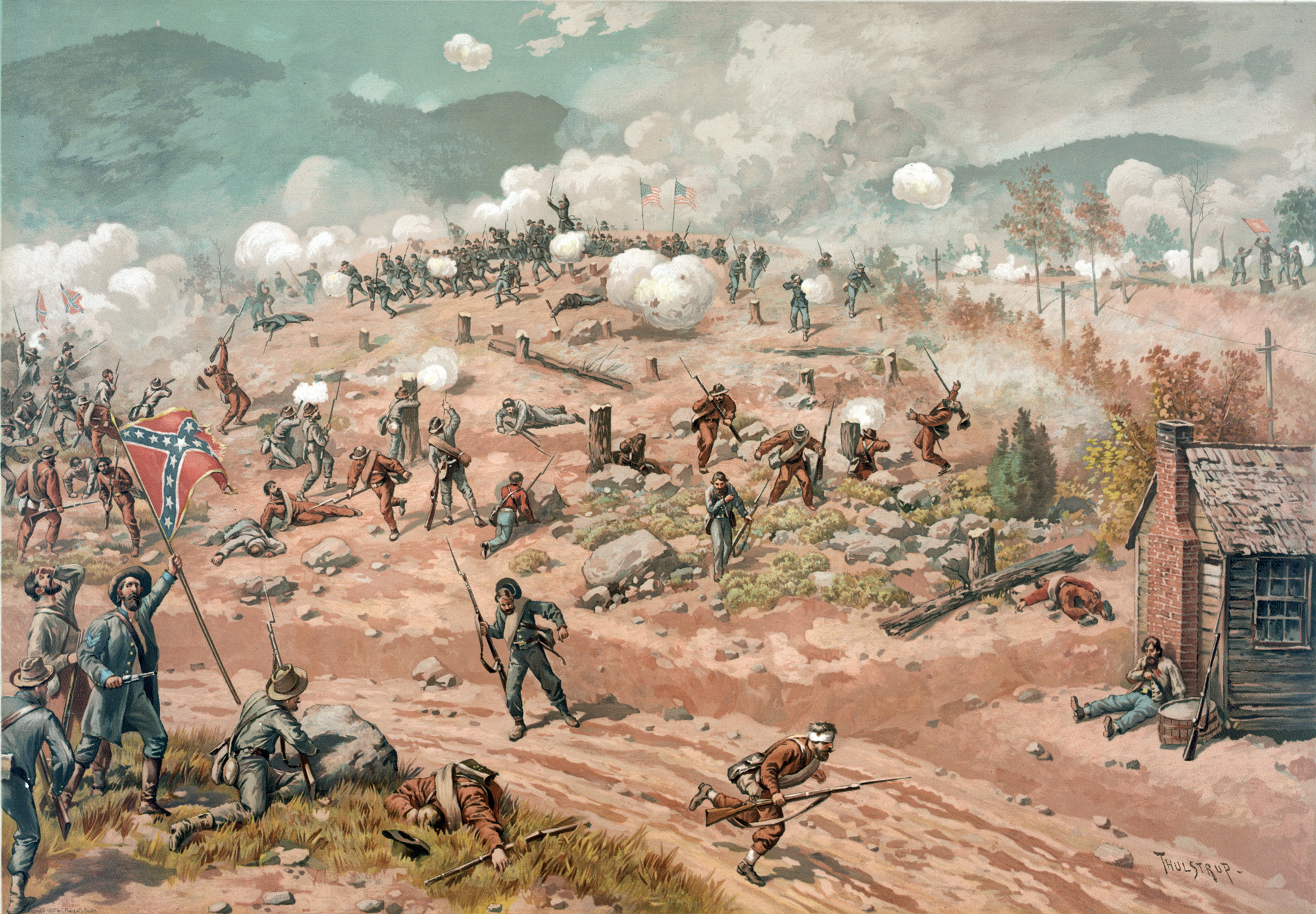

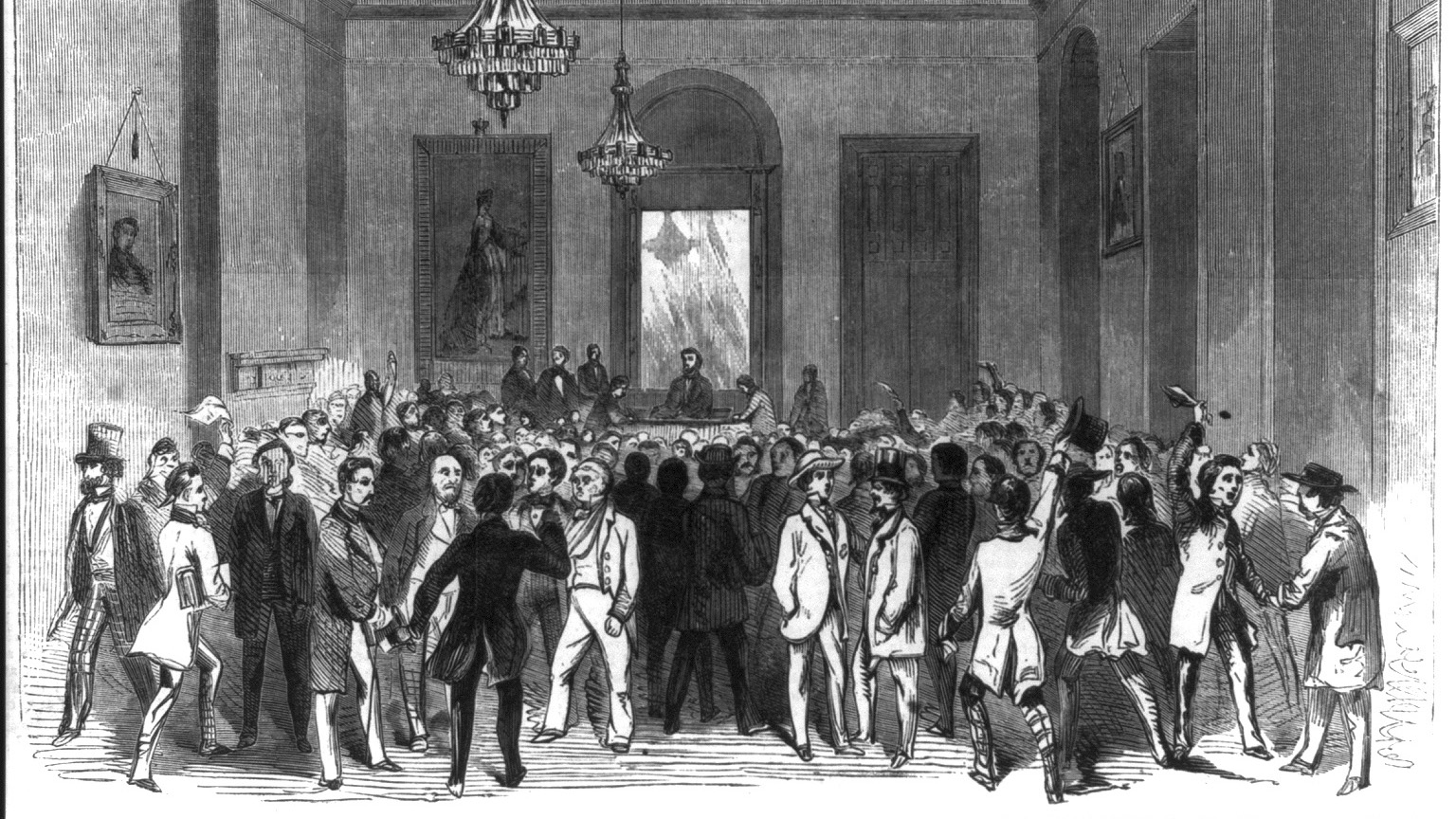
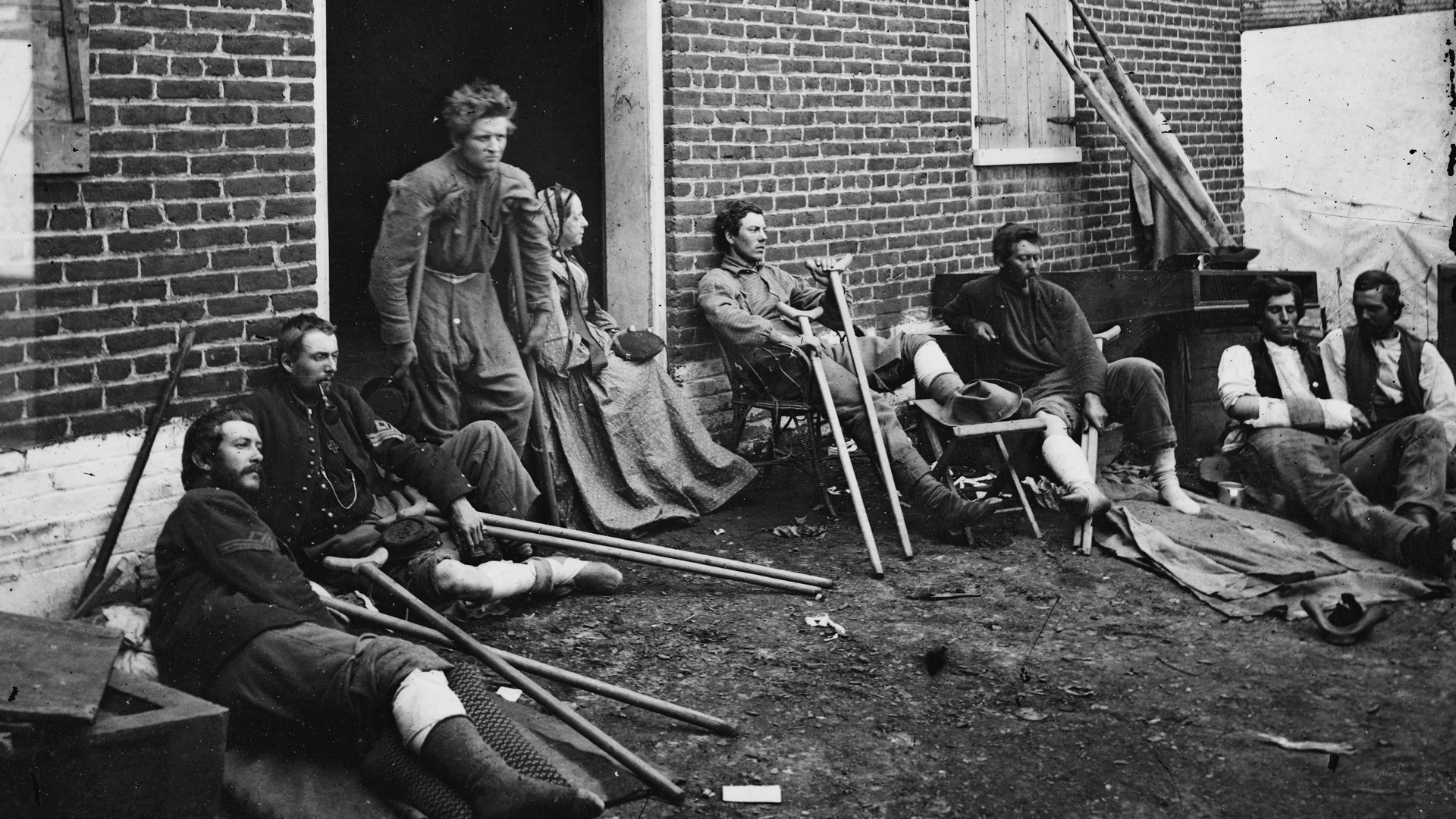
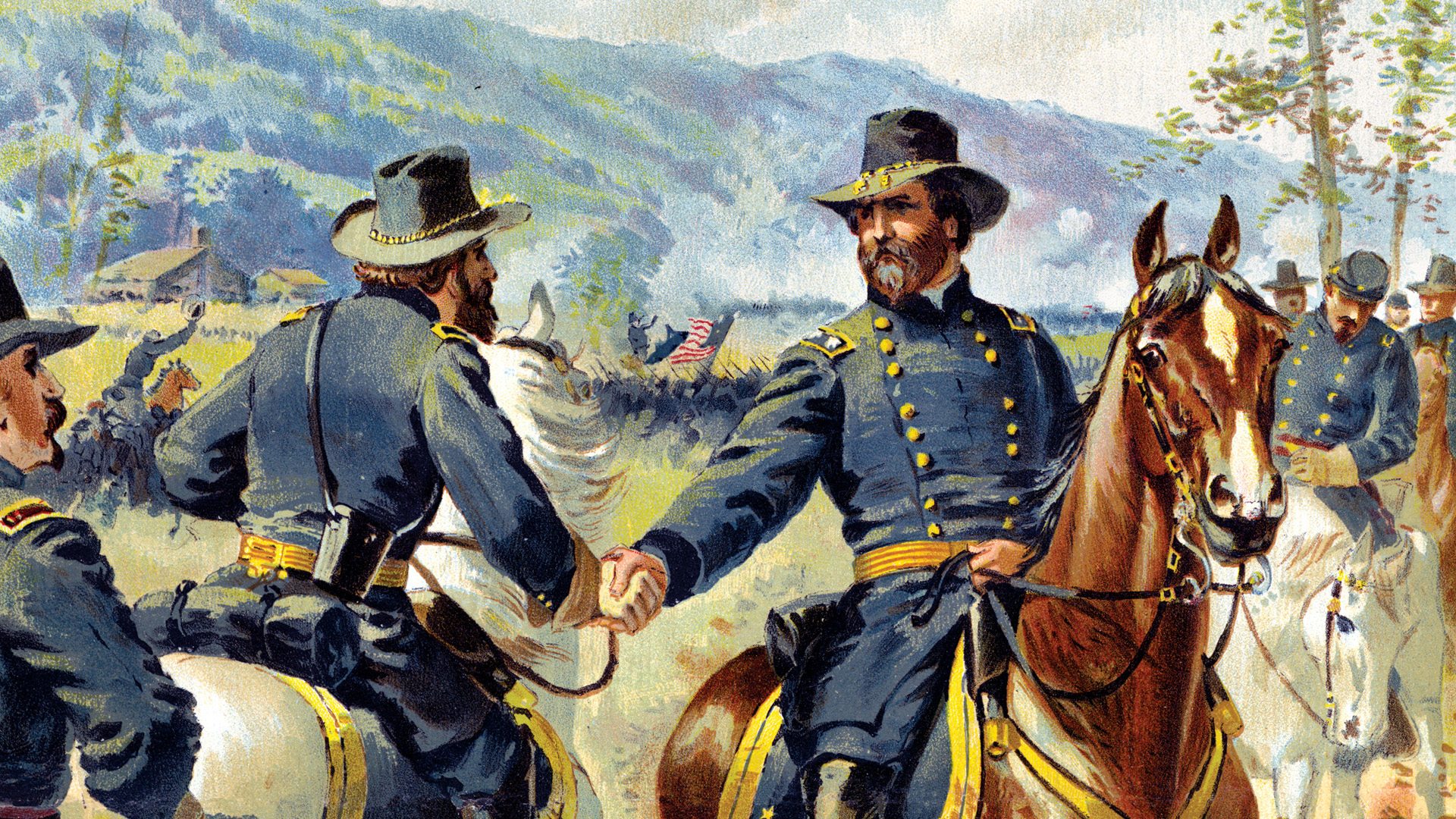
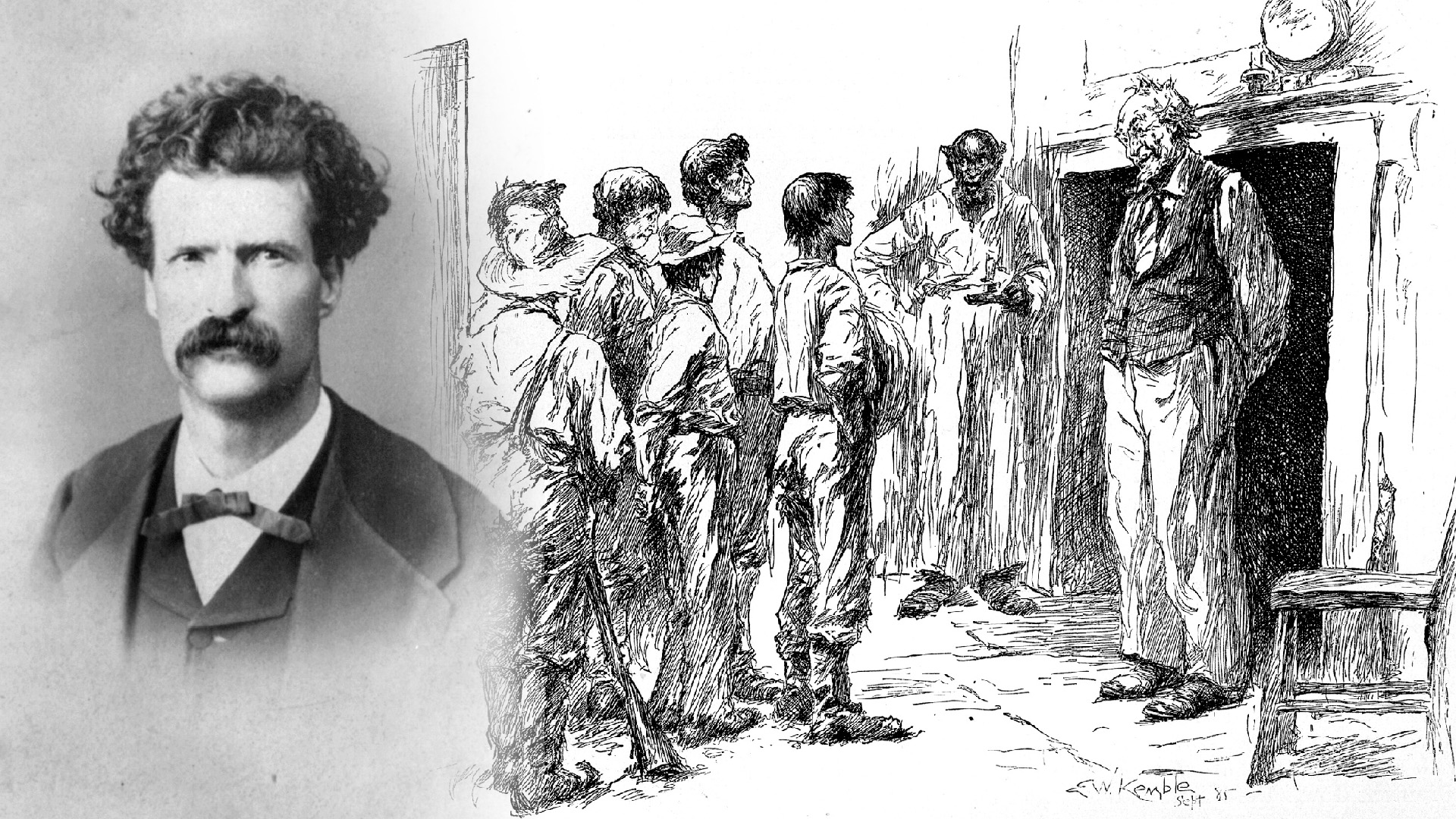
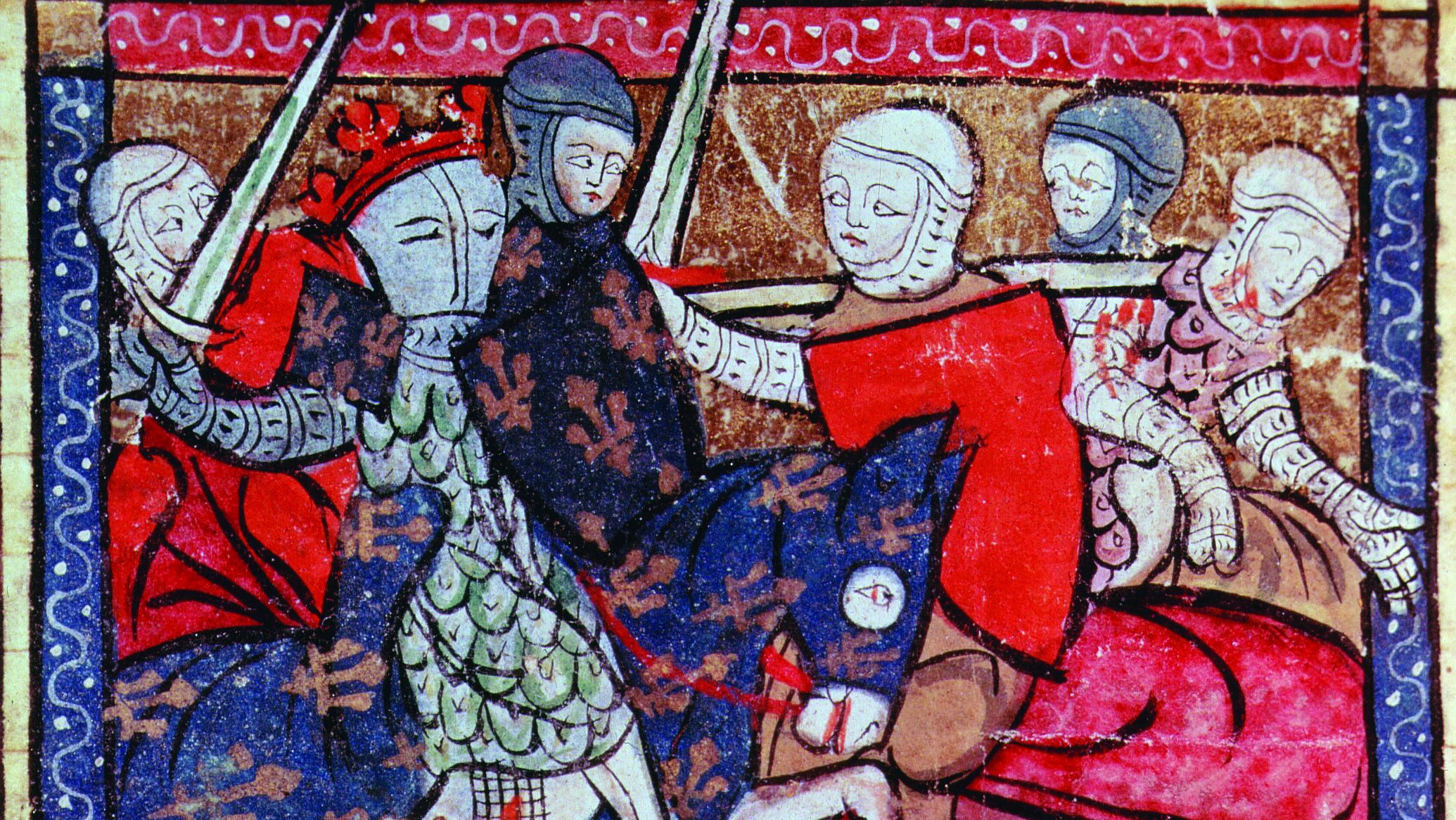
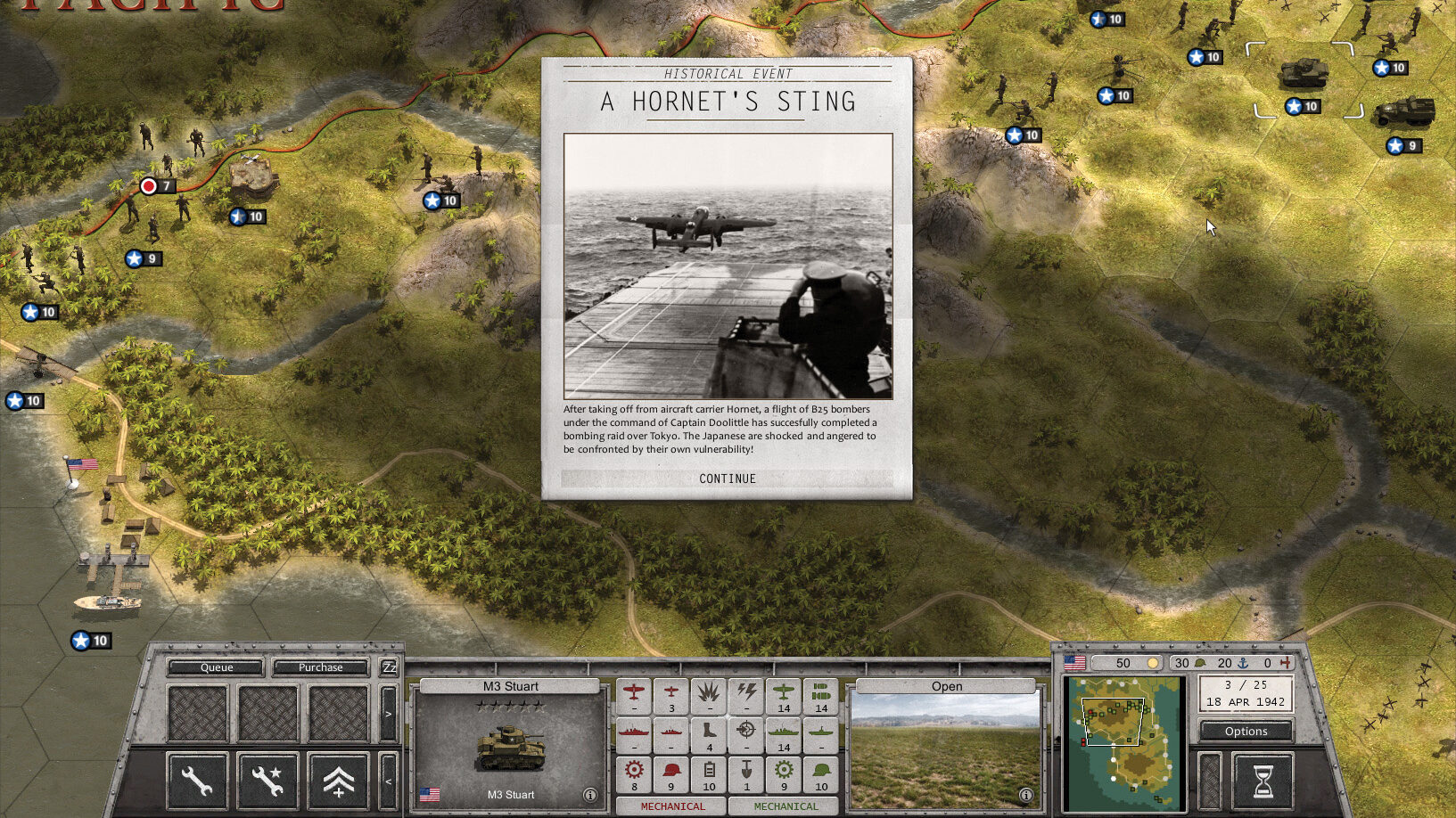
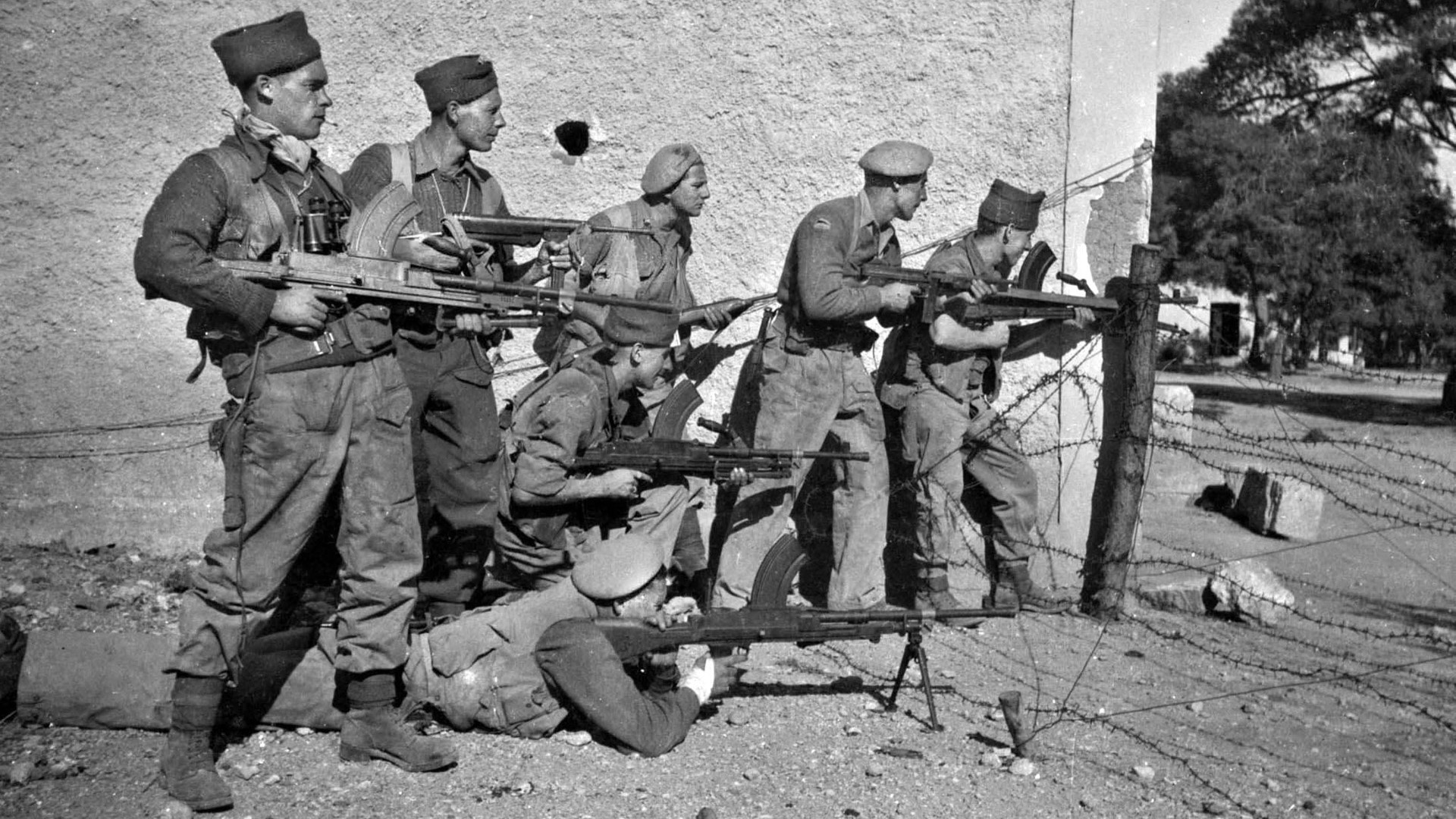
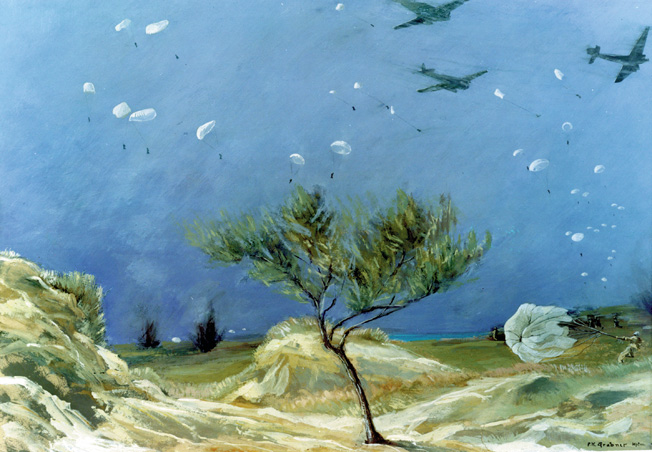
Great story! Thanks!